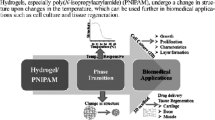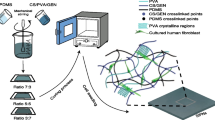Abstract
BACKGROUND:
The development of three-dimensional hydrogels using polymeric biomaterials is a key technology for tissue engineering and regenerative medicine. Successful tissue engineering requires the control and identification of the physicochemical properties of hydrogels.
METHODS:
Interpenetrating network (IPN) hydrogel was developed using thiolated gelatin (GSH) and poly(ethylene glycol) diacrylate (PEGDA), with the aid of ammonium persulfate (APS) and N,N,N,N'-tetramethylethylenediamine (TEMED) as radical initiators. Each component was prepared in the following concentrations, respectively: 2.5 and 5% GSH (LG and HG), 12.5 and 25% PEGDA (LP and HP), 3% APS/1.5% TEMED (LI), and 4% APS/2% TEMED (HI). IPN hydrogel was fabricated by the mixing of GSH, PEGDA, and initiators in 5:4:1 volume ratios, and incubated at 37 °C for 30 min in the following 6 experimental formulations: (1) HG–LP–LI, (2) HG–LP–HI, (3) LG–HP–LI, (4) LG–HP–HI, (5) HG–HP–HI, and (6) HG–HP–LI. Herein, the physico-chemical characteristics of IPN hydrogels, including their morphological structures, hydrolytic degradation properties, mechanical properties, embedded protein release kinetics, and biocompatibility, were investigated.
RESULTS:
The characteristics of the hydrogel were significantly manipulated by the concentration of the polymer, especially the conversion between HP and LP, rather than the concentration of the initiator, and no hydrogel formulation exhibited any toxicity to fibroblast and HaCaT cells.
CONCLUSION:
We provide structural–physical relationships of the hydrogels by which means their physical properties could be conveniently controlled through component control, which could be versatilely utilized for various organizational engineering strategies.







Similar content being viewed by others
References
Zhao H, Liu M, Zhang Y, Yin J, Pei R. Nanocomposite hydrogels for tissue engineering applications. Nanoscale. 2020;12:14976–95.
Jo H, Yoon M, Gajendiran M, Kim K. Recent strategies in fabrication of gradient hydrogels for tissue engineering applications. Macromol Biosci. 2020;20:e1900300.
Xia T, Liu W, Yang L. A review of gradient stiffness hydrogels used in tissue engineering and regenerative medicine. J Biomed Mater Res A. 2017;105:1799–812.
Vega SL, Kwon MY, Burdick JA. Recent advances in hydrogels for cartilage tissue engineering. Eur Cell Mater. 2017;33:59–75.
Ooi HW, Hafeez S, van Blitterswijk CA, Moroni L, Baker MB. Hydrogels that listen to cells: a review of cell-responsive strategies in biomaterial design for tissue regeneration. Mater Horiz. 2017;4:1020–40.
Naahidi S, Jafari M, Logan M, Wang Y, Yuan Y, Bae H, et al. Biocompatibility of hydrogel-based scaffolds for tissue engineering applications. Biotechnol Adv. 2017;35:530–44.
Gibbs DM, Black CR, Dawson JI, Oreffo RO. A review of hydrogel use in fracture healing and bone regeneration. J Tissue Eng Regen Med. 2016;10:187–98.
Li J, Mooney DJ. Designing hydrogels for controlled drug delivery. Nat Rev Mater. 2016;1:16071.
Koshy ST, Desai RM, Joly P, Li J, Bagrodia RK, Lewin SA, et al. Click-crosslinked injectable gelatin hydrogels. Adv Healthc Mater. 2016;5:541–7.
Rodríguez-Rodríguez R, Espinosa-Andrews H, Velasquillo-Martínez C, García-Carvajal ZY. Composite hydrogels based on gelatin, chitosan and polyvinyl alcohol to biomedical applications: a review. Int J Polym Mater Polym Biomater. 2019;69:1–20.
Echave MC, Sánchez P, Pedraz JL, Orive G. Progress of gelatin-based 3D approaches for bone regeneration. J Drug Deliv Sci Technol. 2017;42:63–74.
Hathout RM, Omran MK. Gelatin-based particulate systems in ocular drug delivery. Pharm Dev Technol. 2016;21:379–86.
Han L, Xu J, Lu X, Gan D, Wang Z, Wang K, et al. Biohybrid methacrylated gelatin/polyacrylamide hydrogels for cartilage repair. J Mater Chem B. 2017;5:731–41.
Gyles DA, Castro LD, Silva JOC, Ribeiro-Costa RM. A review of the designs and prominent biomedical advances of natural and synthetic hydrogel formulations. Eur Polym J. 2017;88:373–92.
Gajendiran M, Rhee JS, Kim K. Recent developments in thiolated polymeric hydrogels for tissue engineering applications. Tissue Eng, Part B. 2018;24(1):66–74.
Stillman ZS, Jarai BM, Raman N, Patel P, Fromen CA. Degradation profiles of poly(ethylene glycol) diacrylate (PEGDA)-based hydrogel nanoparticles. Polym Chem. 2020;11:568–80.
Mellott MB, Searcy K, Pishko MV. Release of protein from highly cross-linked hydrogels of poly(ethylene glycol) diacrylate fabricated by UV polymerization. Biomaterials. 2001;22:929–41.
Cho H, Kim J, Kim S, Jung YC, Wang Y, Kang BJ, et al. Dual delivery of stem cells and insulin-like growth factor-1 in coacervate-embedded composite hydrogels for enhanced cartilage regeneration in osteochondral defects. J Control Release. 2020;327:284–95.
Kim K, Lam J, Lu S, Spicer PP, Lueckgen A, Tabata Y, et al. Osteochondral tissue regeneration using a bilayered composite hydrogel with modulating dual growth factor release kinetics in a rabbit model. J Control Release. 2013;168:166–78.
Tsanaktsidou E, Kammona O, Kiparissides C. On the synthesis and characterization of biofunctional hyaluronic acid based injectable hydrogels for the repair of cartilage lesions. Eur Polym J. 2019;114:47–56.
Kim JH, Kim S, So JH, Kim K, Koo HJ. Cytotoxicity of gallium-indium liquid metal in an aqueous environment. ACS Appl Mater Interfaces. 2018;10:17448–54.
Wang MO, Etheridge JM, Thompson JA, Vorwald CE, Dean D, Fisher JP. Evaluation of the in vitro cytotoxicity of cross-linked biomaterials. Biomacromology. 2013;14:1321–9.
Cipitria A, Boettcher K, Schoenhals S, Garske DS, Schmidt-Bleek K, Ellinghaus A, et al. In-situ tissue regeneration through SDF-1alpha driven cell recruitment and stiffness-mediated bone regeneration in a critical-sized segmental femoral defect. Acta Biomater. 2017;60:50–63.
Huebsch N, Lippens E, Lee K, Mehta M, Koshy ST, Darnell MC, et al. Matrix elasticity of void-forming hydrogels controls transplanted-stem-cell-mediated bone formation. Nat Mater. 2015;14:1269–77.
Yu J, Chen F, Wang X, Dong N, Lu C, Yang G, et al. Synthesis and characterization of MMP degradable and maleimide cross-linked PEG hydrogels for tissue engineering scaffolds. Polym Degrad Stab. 2016;133:312–20.
Sun X, Zhao X, Zhao L, Li Q, D’Ortenzio M, Nguyen B, et al. Development of a hybrid gelatin hydrogel platform for tissue engineering and protein delivery applications. J Mater Chem B. 2015;3:6368–76.
Kim S, Kim J, Gajendiran M, Yoon M, Hwang MP, Wang Y, et al. Enhanced skull bone regeneration by sustained release of bmp-2 in interpenetrating composite hydrogels. Biomacromology. 2018;19:4239–49.
Tsou YH, Khoneisser J, Huang PC, Xu X. Hydrogel as a bioactive material to regulate stem cell fate. Bioact Mater. 2016;1:39–55.
Li H, Wijekoon A, Leipzig ND. 3D differentiation of neural stem cells in macroporous photopolymerizable hydrogel scaffolds. PLoS One. 2012;7:e48824.
Annabi N, Nichol JW, Zhong X, Ji C, Koshy S, Khademhosseini A, et al. Controlling the porosity and microarchitecture of hydrogels for tissue engineering. Tissue Eng Part B. 2010;16:371–83.
Matsiko A, Gleeson JP, O’Brien FJ. Scaffold mean pore size influences mesenchymal stem cell chondrogenic differentiation and matrix deposition. Tissue Eng Part A. 2015;21:486–97.
Chen H, Yang F, Hu R, Zhang M, Ren B, Gong X, et al. A comparative study of the mechanical properties of hybrid double-network hydrogels in swollen and as-prepared states. J Mater Chem B. 2016;4:5814–24.
Oyen ML. Mechanical characterisation of hydrogel materials. Int Mater Rev. 2013;59:44–59.
Hu X, Feng L, Xie A, Wei W, Wang S, Zhang J, et al. Synthesis and characterization of a novel hydrogel: salecan/polyacrylamide semi-IPN hydrogel with a desirable pore structure. J Mater Chem B. 2014;2:3646–58.
Oh SH, An DB, Kim TH, Lee JH. Wide-range stiffness gradient PVA/HA hydrogel to investigate stem cell differentiation behavior. Acta Biomater. 2016;35:23–31.
Ghorbani M, Roshangar L, Rad JS. Development of reinforced chitosan/pectin scaffold by using the cellulose nanocrystals as nanofillers: An injectable hydrogel for tissue engineering. Eur Polym J. 2020;130:109697.
Son KH, Lee JW. Synthesis and characterization of poly(ethylene glycol) based thermo-responsive hydrogels for cell sheet engineering. Materials (Basel). 2016;9:854.
Jain E, Hill L, Canning E, Sell SA, Zustiak SP. Control of gelation, degradation and physical properties of polyethylene glycol hydrogels through the chemical and physical identity of the crosslinker. J Mater Chem B. 2017;5:2679–91.
Browning MB, Cereceres SN, Luong PT, Cosgriff-Hernandez EM. Determination of the in vivo degradation mechanism of PEGDA hydrogels. J Biomed Mater Res A. 2014;102:4244–51.
Waldeck H, Kao WJ. Effect of the addition of a labile gelatin component on the degradation and solute release kinetics of a stable PEG hydrogel. J Biomater Sci Polym Ed. 2012;23:1595–611.
Jamadi M, Shokrollahi P, Houshmand B, Joupari MD, Mashhadiabbas F, Khademhosseini A, et al. Poly(ethylene glycol)-based hydrogels as self-inflating tissue expanders with tunable mechanical and swelling properties. Macromol Biosci. 2017;17:856.
Lee JH, Kim HW. Emerging properties of hydrogels in tissue engineering. J Tissue Eng. 2018;9:2041731418768285.
Lam J, Kim K, Lu S, Tabata Y, Scott DW, Mikos AG, et al. A factorial analysis of the combined effects of hydrogel fabrication parameters on the in vitro swelling and degradation of oligo(poly(ethylene glycol) fumarate) hydrogels. J Biomed Mater Res A. 2014;102:3477–87.
Mantha S, Pillai S, Khayambashi P, Upadhyay A, Zhang Y, Tao O, et al. Smart hydrogels in tissue engineering and regenerative medicine. Materials (Basel). 2019;12:3323.
Zustiak SP, Leach JB. Characterization of protein release from hydrolytically degradable poly(ethylene glycol) hydrogels. Biotechnol Bioeng. 2011;108:197–206.
Tong X, Lee S, Bararpour L, Yang F. Long-term controlled protein release from poly(ethylene glycol) hydrogels by modulating mesh size and degradation. Macromol Biosci. 2015;15:1679–86.
Lin CC, Metters AT. Enhanced protein delivery from photopolymerized hydrogels using a pseudospecific metal chelating ligand. Pharm Res. 2006;23:614–22.
Kim S, Lee J, Hwang MP, Wang Y, Kim K. Influence of fiber architecture and growth factor formulation on osteoblastic differentiation of mesenchymal stem cells in coacervate-coated electrospun fibrous scaffolds. J Ind Eng Chem. 2019;79:236–44.
Kim K, Chen WC, Heo Y, Wang Y. Polycations and their biomedical applications. Prog Polym Sci. 2016;60:18–50.
Wilems TS, Lu X, Kurosu YE, Khan Z, Lim HJ, Smith Callahan LA. Effects of free radical initiators on polyethylene glycol dimethacrylate hydrogel properties and biocompatibility. J Biomed Mater Res A. 2017;105:3059–68.
Acknowledgements
This work was supported by the National Research Foundation of Korea (NRF) grant funded by the Korea government (MSIT) (2021R1A4A3024237 and 2019R1A2C1084828).
Author information
Authors and Affiliations
Contributions
SK: Conceptualization, Experiments, Data analysis, Illustration works, and Writing the paper; YC: Biocompatibility experiments and corresponding data analysis and Illustration works; WL: BSA loading efficacy and release experiments and corresponding data analysis; KK: Ideas, Supervision, Writing-Reviewing and Editing, Funding acquisition.
Corresponding author
Ethics declarations
Conflict of interest
The authors disclose no conflicts of interest in this work.
Ethical statement
There are no animal experiments carried out for this article.
Additional information
Publisher's Note
Springer Nature remains neutral with regard to jurisdictional claims in published maps and institutional affiliations.
Rights and permissions
About this article
Cite this article
Kim, S., Choi, Y., Lee, W. et al. Fabrication Parameter-Dependent Physico-Chemical Properties of Thiolated Gelatin/PEGDA Interpenetrating Network Hydrogels. Tissue Eng Regen Med 19, 309–319 (2022). https://doi.org/10.1007/s13770-021-00413-5
Received:
Revised:
Accepted:
Published:
Issue Date:
DOI: https://doi.org/10.1007/s13770-021-00413-5




